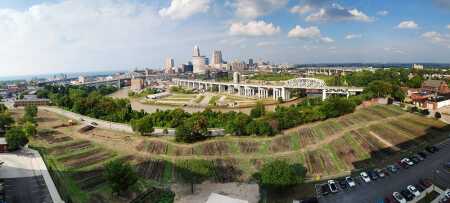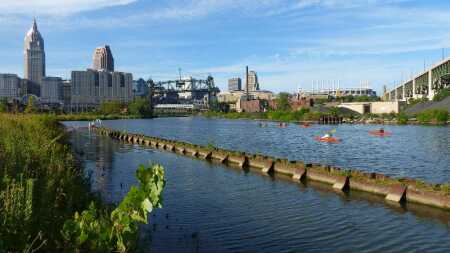In the last decade, Cleveland has done something of an about-face on its view toward its rivers and Lake Erie waterfronts. Historically, the city—like many others in the Midwest—had made industrial facilities, railroads, and freeways its primary use of waterfronts, rather than as open space and human-scale developments. Just as other industrial cities—Chicago, Cincinnati, and Pittsburgh to name a few—are leveraging riverside redevelopment around park space and active transportation, Cleveland is starting to see the fruits of that vision.
After decades of neglect, the 25-acre (10 ha) Scranton Peninsula, very near downtown and located on the Cuyahoga River, has been acquired by Cleveland developer Fred Geis and his partners. The goal is to create a mixed-use, mid-rise (i.e., three- to seven-story) neighborhood with views of downtown and prime access to the Cuyahoga River.
The Scranton Peninsula is at a curve in the river, a half mile (0.8 km) from the city’s downtown center of Public Square, and within walking distance of the resurging older neighborhoods of Ohio City and Tremont. While the plans are very preliminary, it is obvious that the riverfront will be front and center, with terraced parks with river views, narrow streets with pocket parks, and bike and walking trails in proximity.
The Scranton Peninsula development is called “Thunderbird.” The development is designed with a continuous public waterfront, culminating in a park on the southern edge that will connect to the expanding park system including direct adjacency with the new 17-acre (7 ha) park at Irish Town Bend and the existing park on the southern side of the peninsula, creating an active and living waterfront experience on the south bank of the Flats, the brokerage firm CBRE states in an initial informational guide.
The area already has its first announcement of a planned move-in. The Great Lakes Brewing Company—which produces 150,000 barrels of beer a year, sells in 13 states, and employs 250 people—has announced that it will take over eight acres (3.2 ha) in the Scranton Peninsula development and expand its operations. “We have aspirations to make this a modern, urban neighborhood that does the site justice,” Jesse Grant, one of the Scranton Peninsula developers, said in March of the brewery’s decision to expand here rather than in the suburbs.
Cleveland and the surrounding region have been going through a reassessment of waterfront access and urban park development for decades. But in recent years, a big change is that public access to waterfront locations is now a critical element of developments from the start.
“In term of development of the central city, for many decades the need for open space and parks access in Cleveland has been the tail wagging the dog, and it is now switched in that the dog—the developers—are seeing now the tail is what is driving things” says Tim Donovan, executive director of Canalway Partners, a public/private consortium that has been instrumental in developing bike and walking trails throughout the old industrial areas along the Cuyahoga River.
“People in Great Lakes cities like Cleveland are attracted to water because it is in our DNA, and for many years we just couldn’t get our minds around that part of the equation, because the water was used for the dumping of industrial materials in the lake and river,” Donovan says. “But the pendulum has swung the other way in recent years and it’s not done swinging.”
It has been a decades-long approach for better waterfront access for Canalway Partners and other big players in northeast Ohio, like the 100-year-old Cleveland Metroparks with its 18 reservations and 23,000 acres (9,300 ha) of park property. First and foremost, cities and developers are seeing park property near developable property as being a big asset.
The Trust for Public Land’s (TPL) recent study found that Cleveland Metroparks generates about $855 million annually to the local economy because the parks enhance property values, help attract talented workers, boost the local tourism economy, and generate health care cost savings.
The bike and walking trails have been a big part of that economic impact. The Cleveland Metroparks trail system includes more than 300 miles (483 km) of trails for visitors to walk, hike, bike, run, and ride. In surveys done, approximately 70 percent of park visitors have indicated that trails are the primary reason they visit one of the Cleveland Metroparks.
Those trails are now pushing their way into downtown Cleveland and the old industrial areas along the river, known as the Towpath Trail. These trails follow the Cuyahoga River between Cleveland and Akron, following the canal that was built for barge traffic along the river in the 1800s. The process has been difficult and costly, since land acquisitions and cleaning up property that had been left as brownfields for many years take perseverance and long-term thinking.
In fact, that is very much how the process worked in getting the Towpath Trail into this Scranton Peninsula area in 2014. Funding from the Great Lakes Restoration Initiative Fund ($3 million) and the Clean Ohio Conservation Fund ($3.175 million) helped create what was “the first step in connecting the Towpath to downtown, and creating an uninterrupted trail that links Cleveland, Akron, Massillon, and beyond.”Canalway Partners’ Donovan says that that federal, state, and local government groups had been working on the Scranton trail for more than 15 years, and “we are now seeing real estate development follow because people want better access to these open spaces.”
Roughly 90 percent of the trails south of downtown Cleveland have been completed, and the remaining trails and parks in and around the Scranton Peninsula will be mostly finished by 2020. These projects are in addition to a bike trail that will run along the mass transit commuter train path, paddleboarding races and recreation in the river, Friday-night concerts at Edgewater Park on the city’s near west side, and rowing leagues in the Cuyahoga River.
The interest in rowing is one example of how a “sense of place” is more important now and has been redefined. “Research has said that a good sense of place is good economic policy, and the sense of place is greatly determined by the public access of those places,” says Kirby Date, professor of community planning at Cleveland State University. “Those ideas have been out there for a long time, but they are finally taking root more completely and the real estate investors are seeing that.
“It’s all about reinvestment and resurgence that comes from that. Developing better public access to waterfronts is a policy move that more real estate planners are now seeing as a major amenity they need.”
TPL’s study, The Economic Benefits of Cleveland Metroparks, found nearly $1 billion in real economic benefits, but also found the human reasoning behind such benefits. And those exist whether in the inner city or suburbs:
“Study after study has shown that parks and trails have a positive impact on nearby residential property values. All things being equal, most people are willing to pay more for a home close to a nice park or trail. The property value added by park and trail areas is separate from the direct use value gained; property value goes up even if the resident never visits the park or trail.”
About half of all U.S. residents say that access to green spaces is a top priority or high priority when deciding where to live. And neighborhood and community parks can provide up to a 33 percent increase in housing values. Walkable and bike-friendly communities are growing in popularity. Fifty percent of U.S. residents say that walkability is a top priority or a high priority when considering where to live, according to ULI’s America in 2015 report.
Further data show that one in three Americans do not have a park within a ten-minute walk (or half-mile [0.8 km]) of home. That is why TPL, in partnership with the National Recreation and Park Association and ULI, are leading a nationwide movement to help ensure that Americans have access to a great park within a ten-minute walk.
A bipartisan group of approximately 200 mayors have joined in on this effort, which will help focus on advances in park finance and construction; zoning changes and master plans that encourage park development; and other innovations that help further the use of open spaces in urban areas.
Active use of the waterfront has been helping others see the potential for the area. Cleveland residents Mike and Gina Trebilcock, who own MCPc, a technology data management company based in Cleveland, saw their three high school kids were interested in competitive rowing but facilities for the sport were lacking. So, the Trebilcocks went looking for some property along the Cuyahoga River where they might build rowing storage and a workout facility.
Instead, they found a vacant industrial facility built in the 1890s. They bought it in 2013 for $3 million, put in more than 500 linear feet (152 m) of docks on the river, rehabbed the old factory, and opened it up for high school students and older rowers who wanted to practice the sport in the shadow of the downtown Cleveland buildings. The building and rowing business is now called the Foundry.
In the five years since, the area surrounding the Foundry has seen growth in park development, restaurant openings, new and old residential building and conversions, bike trails coming through, and a river so full of rowers that the U.S. Coast Guard has had to oversee the sharing of the Cuyahoga River by freighters hauling iron ore to the steel mills and rowers navigating the river’s crooked layout.
“In 2013, I don’t think we were thinking of doing this as an economic development play; it was more that we saw a need for kids like their children and invested in this to fix that need,” says Peter Anagnostos, vice president of marketing for MCPc and the president of the nonprofit rowing board created by the Trebilcocks.
“But then [the Trebilcocks] saw that this property had worth, and a lot of that has to do with public access to the river,” he says. “There is recreational value, family health value, being close to places downtown, and providing all these things that people are now putting a priority on.”
Across the river from the 500 liner feet (152 m) of docks where the sculling boats come in and out, is the Scranton Peninsula. Within a short time, the rowers will be looking across the river at people who live in the once-barren property, and vice versa.
“It is only a matter of time that further up and down this river fromthis beautiful place of rowing and biking there will be beautiful condos and apartments and retail that will be transforming this area,” Anagnostos says. “Wasn’t easy to see five years ago, but pretty obvious now.”
For additional examples of transformative development through parks and open space, sign up for updates on the 10-Minute Walk Campaign or follow #10MinWalk.










